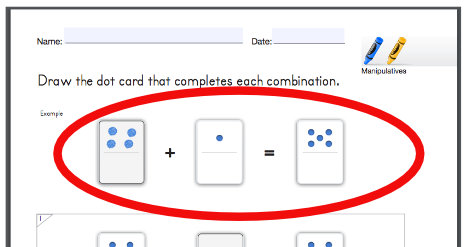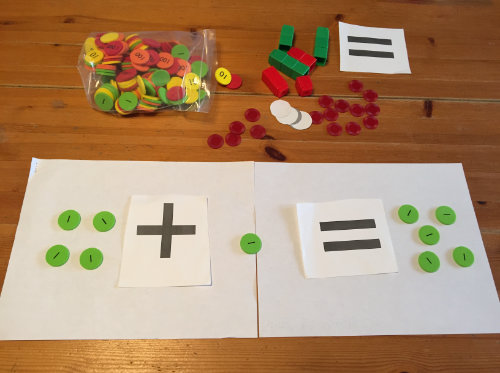The main goal of the Guided Practice worksheets is to engage your students by thinking, building, and talking about the material. A small group session that focuses on these goals will help students explore skills in a deeper way.
Step 1: Determine Your Audience
Sign in to your Administration Panel and look for struggling students in the "HELP" data view. If you have several students showing the same Help lesson, use these students. If not find 1-2 other students who are working in the same Stage.
Step 2: Prepare your Lesson
- Print one copy of the Guided Practice worksheets, or prepare your whiteboard to show the worksheets.
- Organize tabletop materials for the group. Look at the worksheets to determine your materials:
| If you see these on the worksheets: |
... then have these available for students: |
| Symphony bars |
Unifix cubes |
| Dot Cards |
Counting chips, printable dot cards, place value chips |
| Number Lines |
Scrap paper or large number line on desk/floor with counting chips for markers |
| Fraction Bars |
Fraction strips and/or scrap paper |
| Grids |
Unifix cubes and/or scrap paper |
| Numbers and Operators |
Drawn or printed cards with numbers and relevant operators (+,-,=, etc.) |
Step 3: Start your Lesson
Invite students to the table with your materials. Give them the single set of worksheets and say:
"Here are Symphony Math challenges for your group to solve. For each challenge, we will build a model like the one you see, and then build the solution. I will build the example to start."
Build the solution like you see on paper. For example, if you see this:

... then build something like this on your table work space:

After your build your example, say to your group:
"What do you notice?"
Allow your students a few seconds to silently observe the material.
This is a very powerful question. Asking this question puts your students in control of their learning. Students may notice very different things: there is a plus sign, which means adding; we are adding 1 more to a number; or even the materials aren't exactly like the task. Let your students take 1-2 minutes to discuss their observations, and acknowledge the comments that are mathematical in nature. Then move on to the solution. You say:
"How do we know that this solution is correct?"
This may be very challenging for students, but is critical for their understanding. You may want to guide them by using mathematical terms, like "part" and "whole." In the example above, you might want to point to the different parts and say "what does this (the group of four dots) mean?" Having students explain the meaning of "+" and "=" is central to mastering this BIG idea. The time spent on this part of Guided Practice is worth the occasional silence and/or confusion that may arise.
At the end of the discussion, describe the model so that students can hear your language. Point to each part as you speak. In the example above, you would say:
"My model shows 'four', 'plus', 'one', 'equals', 'five'. If I add the parts 'four' and 'one', they are the same as the whole, 'five' ."
Step 4: Work Through Tasks Using Turns to Build, Describe, Solve, and Justify
After you finish the first example, say to your students:
"Let's take turns. First we Build, then Describe, then Solve, then Justify."
Have one student build the next task exactly how it is shown on the Guided Practice worksheet. When the group agrees that they are ready to move on, have the next student mathematically describe the task (i.e. "We are trying to find the missing part that makes '5'.). When the group agrees, have the next student solve the task. Finally, have the next student justify the solution by showing a way that proves the solution is correct. When the group agrees, move on to the next task.
If you are working 1:1, you can be part of this interaction. (Just be sure to alternate your work so that the student gets to work in different roles.) You may need to manage the group's turns carefully for the first few tries. But the routine is always the same, and students will catch on quickly as they practice.
Step 5: Praise Effort and Encourage Reflection
When the lesson time is up, reinforce thoughtful work and interaction. Remember that many of these students are struggling, and need encouragement and praise for their hard work that will someday soon lead to improvements in their math ability.
Provide 1-2 minutes for students to reflect on their work. Choose one or two questions that probe for understanding, like these:
"What are some of the math terms that you heard during this math lesson?"
"Did anything surprise you, or make you think differently?"
"Why can we use different models to build the same number sentences?"
"Can you think of a way to use these models in our other math work?"
|